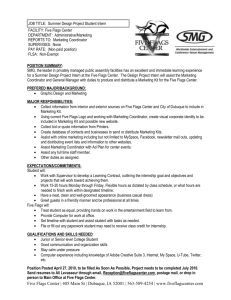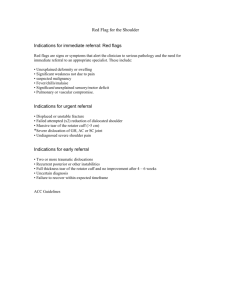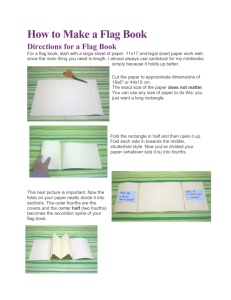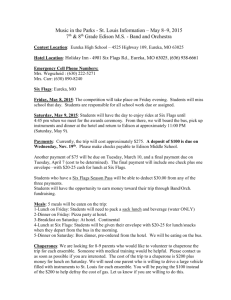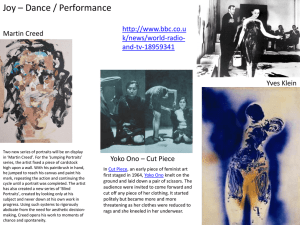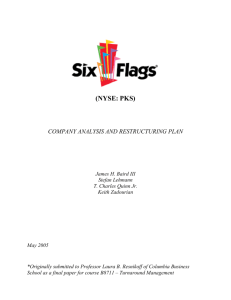TREATMENT PROTOCOL LOWER BACK PAIN
advertisement
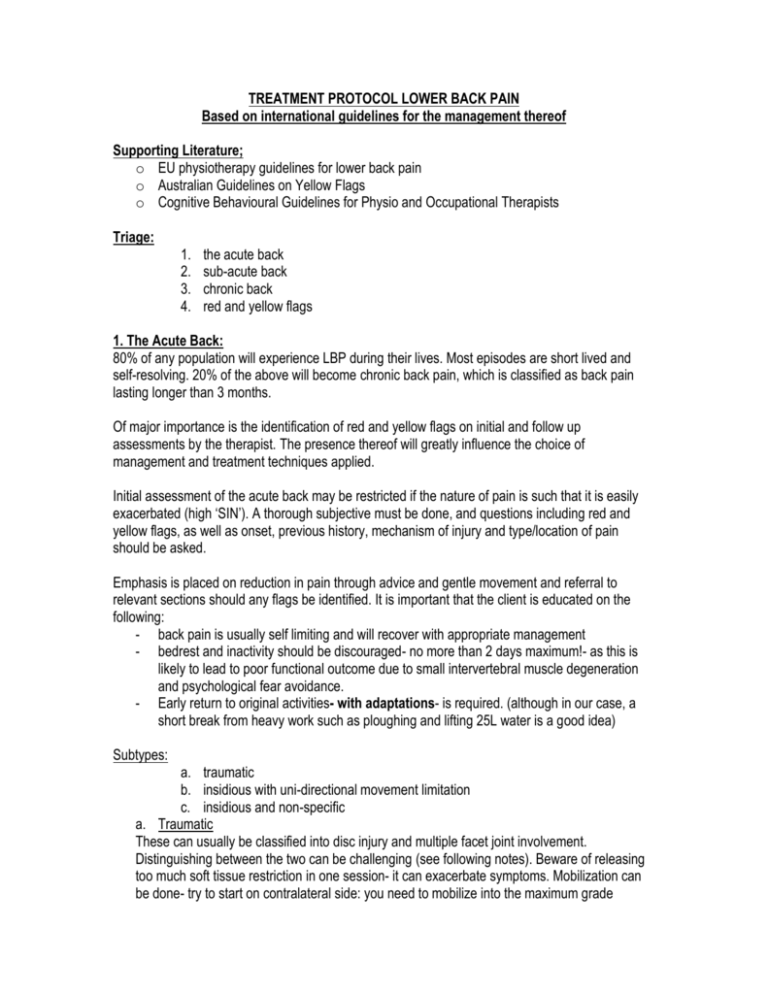
TREATMENT PROTOCOL LOWER BACK PAIN Based on international guidelines for the management thereof Supporting Literature; o EU physiotherapy guidelines for lower back pain o Australian Guidelines on Yellow Flags o Cognitive Behavioural Guidelines for Physio and Occupational Therapists Triage: 1. 2. 3. 4. the acute back sub-acute back chronic back red and yellow flags 1. The Acute Back: 80% of any population will experience LBP during their lives. Most episodes are short lived and self-resolving. 20% of the above will become chronic back pain, which is classified as back pain lasting longer than 3 months. Of major importance is the identification of red and yellow flags on initial and follow up assessments by the therapist. The presence thereof will greatly influence the choice of management and treatment techniques applied. Initial assessment of the acute back may be restricted if the nature of pain is such that it is easily exacerbated (high ‘SIN’). A thorough subjective must be done, and questions including red and yellow flags, as well as onset, previous history, mechanism of injury and type/location of pain should be asked. Emphasis is placed on reduction in pain through advice and gentle movement and referral to relevant sections should any flags be identified. It is important that the client is educated on the following: - back pain is usually self limiting and will recover with appropriate management - bedrest and inactivity should be discouraged- no more than 2 days maximum!- as this is likely to lead to poor functional outcome due to small intervertebral muscle degeneration and psychological fear avoidance. - Early return to original activities- with adaptations- is required. (although in our case, a short break from heavy work such as ploughing and lifting 25L water is a good idea) Subtypes: a. traumatic b. insidious with uni-directional movement limitation c. insidious and non-specific a. Traumatic These can usually be classified into disc injury and multiple facet joint involvement. Distinguishing between the two can be challenging (see following notes). Beware of releasing too much soft tissue restriction in one session- it can exacerbate symptoms. Mobilization can be done- try to start on contralateral side: you need to mobilize into the maximum grade possible (usually a grade 3) for effect. Grade 1 and 2 on the affected side is not usually worth it. The client can be taught self traction (knees on a chair), sleeping positions, gentle knee rolling and pelvic tilts. Encourage log rolling and get the client to demonstrate certain functional movements (dressing, washing, moving in and out of one position to another) and correct them in each. Try an avoid issuing back braces as much as possible, and ESPECIALLY if there are any signs of yellow flags. Screen for flags, refer to Yvonne if yellow flags present. Mobilize. b. insidious with uni-directional movement limitation It is rare to find a restriction in one direction only- usually there is a predominant restriction with secondary restrictions in other directions. Usually facet involvement is the cause. Use the following method to determine which structures are gapped/compressed and stretched/shortened so that you can chose the best mobilization for the restriction: anterior left right Posterior The trick is to start in the position furthest away from the most painful position. For instance, if extension/lat flex left is the worst, start the person in flex/lat flex right, slowly moving the person towards their most painful position with each treatment. If the person is not very irritable, you can start in a more aggravating position. If very irritable, start in the position furthest away. If the problem is a stiff facet joint, I would mobilize on it. If the problem is a nerve root sensitization, I would mobilize on the contralateral side. Remember what plane the facets lie at in Cx (45) vs Tx (60) vs Lx (90)- if you are doing a unilateral pa, are you compressing what should be gapped? If you choose rotations, few clients relax for it to be effective- rather put into crook lie supine (with a towel under buttocks if you want to target lower lumber) and do active rotations, or prone and rotate by stabilizing the Sx and rotating the hemipelvis posteriorly. The most important consideration is: Why does this person have a movement limitation? Usually you will find a considerable amount of asymmetry in their posture which can explain the movement deficit. You will need to address this otherwise it is pointless mobilizing them. Make sure you lift ladies skirts- many an old polio case has been mistaken for a simple pelvic rotation! Think globally, and get them to move through various postures- you will be able to pick up rotations/stuck SIJs/poor unilateral hip stabilities/tight lateral structures/poor segmental control by just observing. Start in closed kinetic chain as soon as possible, and work globally (pilates doesn’t work here, and the link between the HEP and the ADL doesn’t happen). Use your Bobath principles- they are useful and activity related- and sling concepts. Again, always screen for red and yellow flags. Correct asymmetry c. insidious and non-specific Usually these are your instabilities and/or your yellow flags. These are the ladies with no consideration for their spine whatsoever- usually found to hinge badly around L3/4 (unisegmental instability), with consequent stiffness above and below these segments and degeneration as a result (anterior sway or lordotics). Briefly mobilize the segments above and below if you want, but these people need to learn how to maintain a neutral spine, and then how to maintain a neutral spine during lower and upper limb activity. Easier said than done, and much visual feedback using cellphone cameras, the spine model and biofeedback can be done. You need to link it to ADL positions as soon as possible. Occasionally we have multilevel instabilities- treat similarly, but without mobilization. Screen for red and yellow flags. Stabilize. 2. The Sub-acute Back: This is usually the time they eventually get to rehab- it is getting better though! Strict screening for flags- we still have to catch them and refer! The same categories can be applied as above, but patients will usually be of lower SIN and thus a more aggressive treatment can be done. Again, check GLOBALLY for reasons for lower back pain- you will find them through observation! Emphasis must be placed on HEP and activities, with kinetic handling per activity. Self management of pain is essential. 3 & 4. The chronic back and yellow flags: I have grouped these because there are very few patients with chronic back pain and a physiological reason only. Much can be achieved in mobility through correct exercises and activities rather than OMT, and it is easier to grade, steers away from passive treatment and promotes self management. Please note- just because there are yellow flags does NOT mean you do not investigate and treat the underlying pathology!!!!!! Chronic backs need just as much observation, otherwise the exercises given will not be specific and will not support the activity goals set by the patient. If yellow flags present, refer to Yvonne immediately (see screening tool). The earlier you address these, the better the functional outcome and the less likely they are to become a chronic back. The basis for addressing yellow flags is the following: - check for anxiety, depression, fear avoidance (of movement- usually in traumatic backs rather than insidious onset), inappropriate pain beliefs, poor social support from family and or partner, DG/RAF seeking focus, poor incentive to continue/return to work (ie, ADL tasks) and catastrophizing - - - education that some pain during activities is not bad, and that activities must be resumed early, even if the pain has not disappeared entirely. Move away from the ‘broken machine’ explanation- it sometimes becomes a crutch avoid assistive devices such as braces and educate on medicating wisely (don’t overdo) preferably try to find out the root cause of the distress with the patient. Decide together on functional goals (activities) that should be achieved in a specific timeframe, regardless of pain- these should take the physical and emotional barriers into account. Stick to these goals. Goals should be specific, measurable, activity based, realistic (achievable) and have a time frame attached. Do not ask about pain- rather concentrate on function Very important is that the person learns pacing. It is important that they do not experience flare-ups which will result in periods of inactivity and thus deconditioning and an inability to reach goals. The general rule is- find your maximum tolerance for one activity or position, then try to maintain daily participation of 50-80% of this maximum tolerance. Slowly increase this amount. If the person is literate, they can be asked to keep a diary. Steer away from passive treatments (like massage, electrotherapy and OMT) and keep patient involvement in treatment (exercises as well as goal setting) at a maximum. Teach relaxation and self management (hot packs, positioning) techniques.

